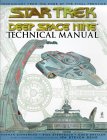
Technical manuals eh? Only for those hard core fans I'll bet. You know the ones...instead of shaking your hand they do some funny thing with their fingers and murmur "live long and prosper". I'll even wager they have a Starfleet uniform tucked safely in their wardrobes. Weirdoes. Well yes I'll give you that, there is that side to it, but these sort of books really appeal to me. While I wouldn't say I'm a real "hard core" fan. I have spent a lot of money on Books, videos to do with the series. Especially DS9. To say that most people have never given it a fair chance is an understatement. DS9 I once read suffers from that infamous "Middle Child Syndrome" It's continually being compared to it's older brother The Next Generation, while at the same time never getting as much attention as it's younger sister series Voyager. Anyway back to this book I'm supposed to be reviewing. The point of all that was an attempt to show that without a doubt DS9 is my favourite Star Trek series, one of the reasons is that the producers, directors and actors manage to convince us every week that instead of being a set somewhere on a lot on Paramount studios, we are in fact on a giant Cardassian built space station somewhere in the Bajoran system. Which is fair enough. But if you, (like me) want to know where exactly in the Bajoran system the station is, then look no further than this book. While we're on the subject how many planets are in the system? And just how close is it to Cardassian space? Well there are fourteen and if I could make sense of the map I could answer that other question. Ladies and Gentlemen I believe I've found geek heaven. This edition improves on the TNG version in one big area, it's in full colour. This means it has a much greater and lasting visual impact than it's older companion. This book I'd say has about two or three full colour diagrams per two-page spread, for those of you who just like looking at the pictures, it's eye candy. For those of you who like text, well it's a little bit easier to understand than the TNG version, however that really isn't saying all that much. Maybe it's just me and my feeble intellect but: "The Y axis runs dorsal-ventral, with +Y to dorsal, up from Ops." Seems a little bit too complicated to me, don't get me wrong I can get my mind round it, it just took me a while, which did kind of spoil the fun. Now the cynic in me (yes I know it's hard to believe, but there is one) will say that this is178 pages of pure um...scanning for PG rated word...nonsense. I mean it's all just been made up hasn't it? It would be like buying a map to a place that doesn't exist...(and yes I do have one of those as well). All that just doesn't matter, this book shows us how the entire station works, the fact that this book treats all the facts, as well...facts, adds to the realism. It's only in the brilliant afterward by Ronald D. Moore that we find out the poly-duranium (or whatever) hull of the station is actually made from wood. As a side note if you turn to page 25 you can actually find out exactly what the hull is supposed to be made from, this book has everything. To do this review I've had to flick through the book again, and now, eight months after I bought it I'm still finding out facts that I never saw before. For instance did you know that in the series we only see about a third of the promenade? The other two-thirds contain "Vince's Gym", a florist, a barber/beauty salon and lots more. You could even go as far as to say that if you were astute enough and had the right technology you could build DS9 and the Defiant just from this book. Just remember if you do, I'll expect an invite and a free synth-ale at Quarks. See you soon. I give this book 5 Pips. |
Title: Star Trek Deep Space Nine Technical Manual
Author: Herman Zimmerman, Rick Sternbach, Doug Drexler
Review by: CL4 Smiley
3-31-05


